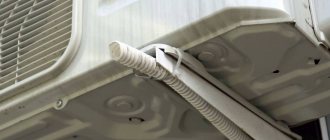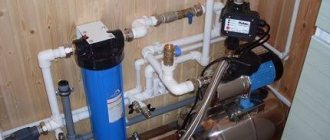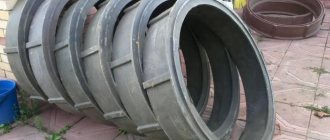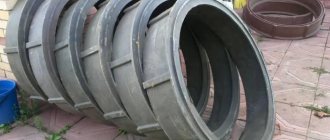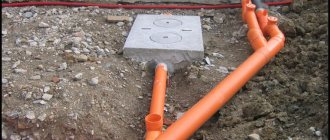If there is only cold water in the house, then living in it can hardly be called comfortable. Often, to solve this problem, it is proposed to install a separate system that will heat the coolant, consuming additional electricity. But if you install a heat exchanger for hot water from heating, you can significantly save energy resources. Let's consider what types of devices are used in private homes, and how they are correctly connected to the heating system.
Plate heat exchanger Source a.allegroimg.com
Heat exchanger features
Let's figure out why a heat exchanger is needed. In the device, two different media share thermal energy. Hot water in one container gives off its temperature to the cold liquid, which moves in another container. And the simplest example is a system of two steel pipes of different diameters.
Cold water moves less. A small section of this pipe is placed in another, larger diameter. The latter contains hot water. And after a short time, the temperatures of both liquids become equal.
In order for the process to proceed steadily and constantly, the water is forced to move (circulate). And giving the flows certain speeds allows you to minimize all heat losses. Moreover, only one energy source is used to heat two systems at once.
This arrangement significantly increases the autonomy of the home. And eliminating unnecessary equipment from operation allows you to be less dependent on network resources. Thereby reducing energy costs in the home.
Stainless steel heat exchanger Source s-ip.com.ua
The performance of the entire system is affected by:
- Device model (design).
- Temperature regime.
- State of the system.
The last point relates to the amount of heat loss. The surface of the pipes through which the liquid moves is responsible for this. If scale has formed on the walls, the heat transfer of the system is significantly reduced. The latter is also influenced by other factors, including simple fat deposits.
In the fight against losses, prevention of blockages and contamination comes first. The heating heat exchanger is equipped with filters that filter out foreign particles and suspension. Also, at certain intervals, the device must be completely cleaned of scale and other deposits. To do this, it is disassembled and washed using special means.
See also: Catalog of companies that specialize in engineering systems (heating, water supply, sewerage and others) and related work
Watch the video: Do-it-yourself autonomous heating
Cold liquid supply
Cold water must flow under high pressure, otherwise the water draw will not be completed. Hot water must be poured out of the boiler, and a special tube for this is located at a high altitude. With low cold water pressure, hot water remains in the tank without rising to the outlet tube from the heater. Thanks to the fitting, the cold water coming from below remains at the bottom of the boiler for heating Leroy Merlin water.
Device classification
Heat exchangers for hot water supply are made of either steel or cast iron. The latter method is more traditional, since not so long ago stainless steel was considered a scarce material. And the use of ordinary metal was unprofitable. Therefore, the system was very quickly damaged by corrosion.
Heat exchanger made of cast iron Source pechiexpert.ru
But even the abundance of modern materials did not exclude the production of cast iron models. After all, their casting is characterized by high speed and extreme simplicity. And today, both conventional cast iron structures and more complex models made of modern steel are equally popular.
Cast iron
A heat exchanger made of this metal has very good performance. And they buy it more for reasons of economy, since its cost is much lower than that of its stainless counterparts. But when purchasing a cast iron structure, you need to be prepared that it has serious disadvantages.
The surface is highly fragile. And any serious blow simply splits it. Cracks can also appear due to thermal exposure. If cold water pressure is applied to a well-heated structure, the walls will most likely not withstand it.
Such damage can no longer be repaired. But otherwise the material is capable of long-term use if treated with care. And it does not require preventive intervention as often as its stainless steel counterparts.
Heat exchanger cassette Source termotactic.ru
Principle of operation
If we consider how a plate heat exchanger works, its operating principle cannot be called very simple. The plates are turned to each other at an angle of 180 degrees. Most often, one package contains two pairs of plates, which create 2 collector circuits: inlet and outlet of the coolant. Moreover, it must be taken into account that the steam located at the edge is not involved during heat exchange.
Today, several different types of heat exchangers are manufactured, which, depending on the operating mechanism and design, are divided into:
- two-way;
- multi-circuit;
- single-circuit.
The operating principle of a single-circuit device is as follows. The coolant circulates in the device throughout the entire circuit permanently in one direction. In addition, a counterflow of heat carriers is also produced.
Multi-circuit devices are used only when there is a slight difference between the temperature of the return and incoming coolant. In this case, the water moves in different directions.
More details about plate heat exchanger:
Two-way devices have two independent circuits. With the condition of constant adjustment of the heat supply, the use of these devices is most appropriate.
Model types
The devices differ in the installation method. And this directly affects the efficiency of the entire system. Very often a boiler design is used that already has a heating heat exchanger inside. Heat losses in such devices are practically reduced to zero. And for productive work all you need is proper configuration.
External structures are much less efficient. Because their position does not allow the coolant to heat up well. But they are used where there are no individual heating boilers. For example, in houses using centralized heating.
Requirements for gaskets
Devices with plates are subject to rather stringent requirements regarding the tightness of the equipment; it is for this reason that today gaskets have begun to be made from polymers. For example, ethylene propylene can easily be used at elevated temperatures - both steam and liquid. However, it begins to deteriorate quite quickly in an environment that contains large amounts of fats and acids.
Heat exchangers differ in the number of plates
The seals are attached to the plates most often using clip locks, and in rare cases - using an adhesive.
System installation
Since the internal heat exchanger is connected to the system at the same time as the heating boiler, only the installation of external devices needs to be considered separately. This operation is not difficult. You just need to check that there is a thread at the inlet and outlet of the device. Otherwise, you will have to take special care in cutting it.
Connecting the heat exchanger to the network requires fixing it to the wall. If a cast iron structure is used, then the fasteners are selected with special strength. It is best to use a special console.
For insertion into the system, specific couplings are used, which will also be needed if there is a desire to provide the structure with additional water filters. In some cases, two of them are installed at once. This arrangement is used for old heating systems.
You will also need standard taps and American ones. The latter consist of two threaded fittings, a gasket and a union nut.
Indirect heating boilers
The most common water heaters are Leroy Merlin indirectly heated boilers. Heating is carried out from a tubular electric heater, a gas burner, and the heat of the heating system. The housing is protected by a special casing and thermal insulation to prevent heat loss through the Leroy Merlin water heater. The control panel is equipped with a temperature sensor and is connected to a heating device. When the sensor signals a decrease in temperature, the heating is turned on automatically.
Closed boilers
Closed Leroy Merlin boilers are used in centralized heating. Attention! Due to the expansion of the coolant when heated, increased pressure is created in such systems, which can cause system elements to fail. To avoid this, an expansion tank is provided for excess water; pressure gauges, thermal mixers, and pressure reducers can be installed.
Open type boilers
An open Leroy Merlin boiler can supply only one water point with hot water. They contain a special mixer, which allows you to shut off the connection of the heat exchanger to the main line. Increased water pressure is observed not at the outlet, but as it flows into the heater, due to which not the most expensive and durable materials can be used in the production of such devices. The special mixer also allows you to drain excess water when the pressure in the system increases. This element can also be used in closed boilers, but in open ones it is required.
We increase the efficiency of the furnace
door to the firebox and ash pan; it is advisable to provide a damper; side metal screens
Potbelly stove in casing
Round furnace with afterburner and casing with heat gun
A stove with elbows for a chimney,
the throughput of the chimney, blowing the chimney with a fan firewood in the stove with slots and a valve, strips of metal buckets or a metal box with sand, sand backfill or a heat accumulator made of stones
Scheme of a potbelly stove with sand backfill, the stove is made of a pipe with a diameter of 500 mm, its length is 650 mm,
lined with 1-2 layers of brick
Brick screen
area of its walls bricks or metal sheet Video on the topic: Do-it-yourself potbelly stove stove
Design advantages
Despite the emergence of more and more economical wood-burning stoves and boilers, the old potbelly stove remains quite in demand, this is explained by its advantages:
- simple device. There are no high-tech components in the oven, so anyone can make it themselves;
- low cost. This "plus" stems from the previous advantage;
- ease of use. Heating a potbelly stove is extremely simple; you don’t need to know any subtleties. All you need to do is select the correct volume of the bookmark;
- omnivorous. The heater operates on any fuel, including used engine oil;
- multifunctionality. A potbelly stove can be equipped with a hob and a water circuit, which significantly increases its value for a living space;
- multi-mode. In addition to the usual functionality with direct combustion, a properly designed stove is capable of operating in smoldering mode (the duration of heating on one tab increases);
- efficiency. With all these advantages, there is also a good efficiency of 60% if the assembly is carried out in compliance with the rules set out below.
Where to use a homemade furnace for mining
Since during the combustion process engine oil, especially used one, does not emit the most pleasant odor, and from a health point of view it is not very useful, it is better not to use stoves of this kind in residential premises. If there is no other way out, high-quality removal of combustion products is mandatory.
Typically, stoves are installed in non-residential premises - utility rooms, garages, sheds, workshops, and so on - where constant heating is not required, but only warming up the air for a relatively short time.
Due to the fact that even the simplest designs of such a “garage stove” make it possible to regulate the intensity of fuel combustion, it is possible to ensure either an economical mode of its use and gradual heating of the premises, or increased consumption with very fast heating of the air volume.
What is so attractive about a potbelly stove?
Although in this case half of the thermal energy evaporates through the direct-flow pipe. But no one writes off even a heating source that has rusted over time as scrap.
Such a temporary stove can be easily made in a day or two. But first, make your own drawings of the potbelly stove. Much of what is stored in the closets of rural houses and dachas is used. These are milk and water metal (not duralumin) cans, barrels for diesel fuel, vegetable oils, pipes, boxes, corners.
Nothing expensive, including tools - in villages every owner has them at hand. High-quality assembly using gas or electric welding.
But neighbors who have units will help with this. Welding machines provide greater reliability and rigidity of the assembly. Below are step-by-step instructions on how to make a potbelly stove with your own hands.
Determining the volume of fuel fill
For the potbelly stove to operate efficiently, it is important to load the optimal amount of fuel into it, and for each type of fuel it is necessary to find its own indicator.
If you overload the furnace, there will be too many combustion products and they will block circulation; if you underload, there will be few of them, which also makes circulation impossible. The bookmark volume is selected as follows:
- fuel is collected in a bucket;
- they take a handful from the bucket and, placing it in the firebox, set it on fire;
- add fuel in small portions until the initial section of the hog is cherry red hot. Now they estimate how much fuel is taken from the bucket - this is the minimum volume of the stowage;
- continue to add fuel (the portions must be increased) until the dimensions of the hot section reach 80%-85% of the length of the “hog”. At this moment, the volume of fuel taken from the bucket will correspond to the maximum fuel load.
The test is carried out in moderate lighting: if during the day, then in cloudy weather (winter); If it’s clear outside, it’s closer to evening. When loading high-calorie fuel (pellets, anthracite), the hot area sometimes takes the form of a ring with different widths, occupying different positions along the length of the hog.
Then the volume of the bookmark is determined as follows:
- maximum: the section of the hog farthest from the furnace is hot for 1/3 of its length;
- minimal: the hot zone is located in the middle and is 3-4 palms long.
Kinds
Based on their design, devices of this class are divided into two main categories:
- tubular,
- lamellar.
For domestic needs, plate-type devices are used due to greater ease of use and efficiency, as well as easy transportation and installation. Among tubular devices in everyday life, as a rule, the shell-shaped version is used.
Lamellar
Plate type heat exchangers are a structure of plates installed parallel to each other and connected in a single housing . The heat carrier and heat receiver flow in separate pipes connected to communications on the front and rear panels of the device.
Plate heat exchangers are in turn divided into three groups:
Collapsible. In this version, rubber seals are used to ensure the tightness of the structure.
The advantages of collapsible heat exchangers are ease of installation and use.The downside is the regular need to replace rubber gaskets and sensitivity to aggressive substances.
- Soldered. The design of such devices is more durable and is made of steel. Unlike collapsible ones, they rarely require maintenance and are tolerant to any environment. The disadvantage is the large weight of the structure and the impossibility of disassembling it, resulting in more difficult transportation.
- Welded. Made from heavy metals, used only in industry.
Tubular
This type of device is used mainly in industry, and also as structural elements of air conditioners and refrigerators.
They are used less frequently for heating water, since to ensure the same efficiency as from the plastic type, such a device must be quite large in size.
The advantage of this type is its high resistance to any conditions and environments . A common design is when another narrower one is located inside one wide pipe. The heat carrier flows through the inner pipe, and the receiver flows through the outer pipe.
In turn, tubular exchangers are divided into several types:
Case-like. A large number of tubes connected in a lattice.
It is possible to connect several devices of this type to achieve greater efficiency.This type is most often used in everyday life among tubular exchangers.
- Twisted. The pipes are twisted together around a single core. It is a compact and quite effective option. A variation of this design are spiral heat exchangers, in which both channels wrap around a single partition.
- Irrigation exchangers are designed in a spiral shape. Water flows down the gutter. Mainly used in ventilation systems.

